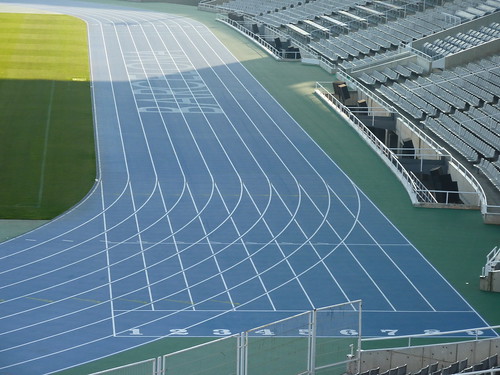 Track coaches may have had it right all along.
Track coaches may have had it right all along.
I am one of the first people that will advocate for science-based strategies for training and injury recovery. But I am not averse to acknowledging what may have been done well in the past, without the benefit of sports science. This is where the track coach of yore comes in.
You see, track coaches in the 1970's probably had a lot of sound concepts already in place to make better runners, long before the running community evolved into a mass of fads, testimonials and marketing plans.
Let's jump into the time machine and go back to 1970. Back in the day, long before marathon training groups popped up on every street corner in the United States, there was the track club. These clubs focused on interval-based training. Track coaches focused on improving your running mechanics. As I have found over many years of working with runners, running mechanics are typically better when you run on the faster end of your individual running pace continuum; alas, the biomechanical benefits of interval-based training. The track coach had you do drills and plyometrics on the infield (or perhaps even on the track itself) to encourage eccentric strengthening. You might have done so in your bare feet, a lightweight trainer, or a track spike. The coach probably put you in as little shoe as you needed: the athletic demands were placed on the strength of the lower extremity, and it was simply easier to not lug a heavy shoe around the track.
Oh, those were the days. The focus was on running, and running fast - relative to the individual, of course.
Then, as I mentioned earlier, came the premise that you could train for a marathon in 6 months, regardless of your starting point. There was money to be made throughout the running community. It started with the advent of the countless marathon training groups. The trend could be seen in midsole design, motion control shoes, and orthotics. Countless runners were put in shoes with more support. Then, there was the minimalist "revolution" in which athletes were moving towards shoes with a minimal, zero drop midsole - or no shoes at all. And now, if we look at the market place and the community as a whole, it is swinging back in the opposite direction yet again.
Ugh. If there is one thing I despise, it is fads.
Sometimes, with the benefit of hindsight, you discover that things were done well from the get-go. Case in point: that which was done by many track coaches 40 years ago without the benefit of the sport sciences. They put you in as little shoe as necessary. They focused on your running mechanics. They emphasized drills and intervals. They made you a better runner.
They didn't focus on slogging out 10 mile runs at a pace that is 2:00 slower than your goal marathon pace. Or put you in compression socks. Or some other similar garbage geared to "help you to burn fat".
You simply got out and ran, much like children do when left to their own devices.
Is there a shoe that is right for you? Absolutely. But with that said, it is time to go back to the track - with as little shoe as you need, while building your pace, your eccentric muscle strength, and your running form.
Let's get back to making better runners - and make them smarter along the way with the benefits of our current understanding of the sport sciences and how these principles apply to training and recovery.
The running community as a whole would be a better place because of it.
Photo credits: Sean MacEntee
 "Running Injuries: Etiology And Recovery- Based Treatment" (co-author Bridget Clark, PT) appears in the third edition and fourth editions of "Clinical Orthopaedic Rehabilitation: A Team Approach" by Charles Giangarra, MD and Robert C. Manske, PT.
"Running Injuries: Etiology And Recovery- Based Treatment" (co-author Bridget Clark, PT) appears in the third edition and fourth editions of "Clinical Orthopaedic Rehabilitation: A Team Approach" by Charles Giangarra, MD and Robert C. Manske, PT.
 Allan Besselink, PT, DPT, Ph.D., Dip.MDT has a unique voice in the world of sports, education, and health care. Read more about Allan here.
Allan Besselink, PT, DPT, Ph.D., Dip.MDT has a unique voice in the world of sports, education, and health care. Read more about Allan here.
 Top 5 finalist in three categories: "Best Overall Blog", "Best PT Blog" and "Best Advocacy Blog".
Top 5 finalist in three categories: "Best Overall Blog", "Best PT Blog" and "Best Advocacy Blog".